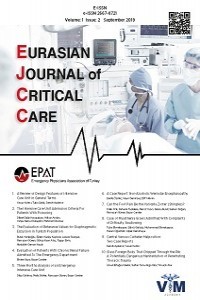DIAGNOSING MENINGITIS AT THE EMERGENCY DEPARTMENT – HOW ACCURATE ARE WE?
DIAGNOSING MENINGITIS AT THE EMERGENCY DEPARTMENT – HOW ACCURATE ARE WE?
Diagnosis, Emergency Medicine, Meningitis,
___
- 1. Scheld W, Koedel U, Nathan B et al. Pathophysiology of Bacterial Meningitis: Mechanism(s) of Neuronal Injury. J Infect Dis. 2002;186(s2):S225-33.
- 2. WHO Report on Global Surveillance of Epidemic-prone Infectious Diseases. World Health Organization. Website. Available at: https://www.who.int/csr/resources/publications/surveillance/Meningitis.pdf . Accessed 12 April 2019.
- 3. Thigpen M, Whitney C, Messonnier N et al. Bacterial Meningitis in the United States, 1998–2007. N Engl J Med. 2011;364(21):2016-25. 4. Levy M, Wong E, Fried D. Diseases That Mimic Meningitis. Clin Pediatr (Phila). 1990;29(5):254-61.
- 5. Rømer F. Difficulties in the Diagnosis of Bacterial Meningitis. Lancet. 1977;310(8033):345-7.
- 6. Thomas K, Hasbun R, Jekel J et al. The Diagnostic Accuracy of Kernig’s Sign, Brudzinski’s Sign, and Nuchal Rigidity in Adults with Suspected Meningitis. Clin Infect Dis. 2002;35(1):46-52.
- 7. Curtis S, Stobart K, Vandermeer B, et al. Clinical Features Suggestive of Meningitis in Children: A Systematic Review of Prospective Data. Pediatrics. 2010;126(5):952-60.
- 8. Stovring J, Snyder R. Computed Tomography in Childhood Bacterial Meningitis. J Pediatr. 1980;96(5):820-3.
- 9. Akhvlediani T, Shakarishvili R, Tsertsvadze T. The Role of Imaging Studies in CNS Infections. Georgian Med News. 2008;(165):94-8.
- 10. Minonzio G, Paolucci Colico M, Ghezzi A et al. Imaging of Cranio-meningeal Infectious and Inflammatory Involvement. Neurol Sci. 2008;29(S2):279-82.
- 11. Haslam R. Role of Computed Tomography in the Early Management of Bacterial Meningitis. J Pediatr. 1991;119(1):157-9.
- 12. van de Beek D, de Gans J, Spanjaard L et al. Antibiotic Guidelines and Antibiotic Use in Adult Bacterial Meningitis in The Netherlands. J Antimicrob Chemother. 2002;49(4):661-6.
- 13. Proulx N, Frechette D, Toye B et al. Delays in the Administration of Antibiotics Are Associated With Mortality From Adult Acute Bacterial Meningitis. QJM. 2005;98(4):291-8.
- 14. Bryan C, Reynolds K, Crout L. Promptness of Antibiotic Therapy in Acute Bacterial Meningitis. Ann Emerg Med. 1986;15(5):544-547.
- 15. Fitch M, van de Beek D. Emergency Diagnosis and Treatment of Adult Meningitis. Lancet Infect Dis. 2007;7(3):191-200.
- 16. Bacterial Meningitis. Centers for Disease Control and Prevention. Web site. Available at: https://www.cdc.gov/meningitis/bacterial.html. Accessed August 12 April 2019.
- 17. Aronin S, Peduzzi P, Quagliarello V. Antibiotic Timing and Risk Stratification System in the Management of Community-acquired Bacterial Meningitis. J Am Osteopath Assoc. 1999;99(2):83.
- 18. Mclntyre P. Dexamethasone as Adjunctive Therapy in Bacterial Meningitis. JAMA. 1997;278(11):925.
- 19. Havens P. Corticosteroids as Adjunctive Therapy in Bacterial Meningitis. Am J Dis Child. 1989;143(9):1051.
- 20. Brouwer M, Heckenberg S, de Gans J et al. Nationwide Implementation of Adjunctive Dexamethasone Therapy for Pneumococcal Meningitis. Neurology. 2010;75(17):1533-9.
- 21. Brouwer M, McIntyre P, Prasad K et al. Corticosteroids for Acute Bacterial Meningitis. Cochrane Database of Syst Rev. 2015 Sep 12;(9):CD004405.
- 22. Scarborough M, Gordon S, Whitty C et al. Corticosteroids for Bacterial Meningitis in Adults in Sub-Saharan Africa. N Engl J Med. 2007;357(24):2441-50.
- 23. Mai N, Chau T, Thwaites G et al. Dexamethasone in Vietnamese Adolescents and Adults with Bacterial Meningitis. N Engl J Med. 2007;357(24):2431-40.
- 24. Hand W. Posttraumatic Bacterial Meningitis. Ann Intern Med. 1970;72(6):869.
- 25. Park M, Hospenthal D, Bennett J. Treatment of Hydrocephalus Secondary to Cryptococcal Meningitis by Use of Shunting. Clin Infect Dis. 1999;28(3):629-33.
- 26. De Wytt C, Dickson P, Holt G. Cryptococcal meningitis. J Neurol Sci. 1982;53(2):283-92.
- Başlangıç: 2019
- Yayıncı: Acil Tıp Uzmanları Derneği
A Rare Cause of Pediatric Acute Abdomen: Isolated Tubal Torsion
Mehmet ATALAR, Neslihan KÖSE, Cengiz GÜNEY, Levent CANKORKMAZ
Post partum mortality; WHY? Sheehan’s Syndrome
Ahmet Burak ERDEM, Hakan UZUNKAYA, Muhittin YILMAZ, Bahattin IŞIK, Umut ÇAVUŞ
Migration of Intrauterine Device and Acute Abdomen
İbrahim ÇALTEKİN, Emre GÖKÇEN, Levent ALBAYRAK, Dilek ATİK, Atakan SAVRUN, Mikail KUŞDOĞAN, Hasan KAYA, Sevilay VURAL, Şeyda Tuba SAVRUN
Pneumonia with systemic lupus erythematous
Fatma KOLBAŞ, Hatice AKÇA, Abdullah ALGIN, Serdar ÖZDEMİR, Serkan Emre EROĞLU
DIAGNOSING MENINGITIS AT THE EMERGENCY DEPARTMENT – HOW ACCURATE ARE WE?
Dennis Clement FORSYTHE, Ling TİAH, Jen Heng PEK
An insight into the neurological manifestations of COVID-19 in the emergency department
Young patient applying to emergency room with complaint of syncope
Sinan Cem GÜL, Celal BİTİŞ, Basar CANDER
Turgut TEKE, Taha Ulutan KARS, Korhan KOLLU
Management of Sigmoid Volvulus Patient Diagnosed by Emergency Department
Sinan Cem GÜL, Ahmet ERDUR, Uğur ÖZSOY, Hüseyin BAKIR, Murat YILDIRIM
